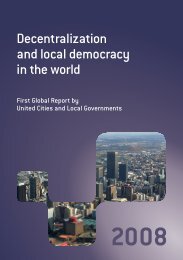Making Cities Resilient Report 2012
Making Cities Resilient Report 2012
Making Cities Resilient Report 2012
You also want an ePaper? Increase the reach of your titles
YUMPU automatically turns print PDFs into web optimized ePapers that Google loves.
as a potential long-term partner. Local governments need to be able to present their ‘business case’ for<br />
investing in resilience when engaging with private companies.<br />
Another barrier to building public-private sector partnerships may be a lack of communication. For<br />
instance, local governments may be unaware that most large companies are undertaking some form of<br />
resilience-building activity (including insurance and contingency plans), which could benefit local level<br />
risk reduction plans and activities.<br />
Many cities, though, are forging successful relationships with business. Cape Town, Makassar and Makati<br />
report the use of corporate social responsibility funds from private companies for risk reduction and postdisaster<br />
recovery. Chacao, Venezuela recognises the private sector as a key stakeholder for resilience<br />
building and has a risk management network of 33 companies, which are encouraged to prioritise<br />
self-protection, take ownership of the risks they face and take action (55). In Siquirres, Cape Town, and<br />
San Francisco, Cebu, the private sector has volunteered expertise or donated materials for disaster<br />
risk reduction initiatives. The Province of Tyrol has established a risk management system through a<br />
partnership with the alpS Centre for Climate Change Adaptation Technologies. This allowed an area-wide<br />
risk assessment to be carried out with direct links between this research centre and the risk management<br />
process. AlpS also provides support to municipalities for their local disaster risk reduction activities and<br />
connects them to relevant national and international partners (64).<br />
Box 4.2 : The private sector’s role in disaster risk reduction<br />
As the primary generator of wealth and the main employer in most cities, small and medium enterprise<br />
and other private sector should be at the centre of the urban disaster risk reduction agenda.<br />
As cities grow, so too does the economic imperative for business to address disaster risk. Earthquakes,<br />
floods, drought and other events can severely disrupt the critical systems, distribution networks and<br />
infrastructure that are vital to a company’s operations, and which can cause significant, long-term financial<br />
and reputational impacts. Large-scale events can also interfere with shorter-term market dynamics,<br />
artificially depressing or inflating stock prices. On average, large businesses with robust risk management<br />
programmes realise catastrophe losses that are seven times less costly than those companies with<br />
immature risk programmes —an average of US$478,000 per loss compared with US$3.4 million 11 .<br />
11. Dr Deborah Pretty, Oxford Metrica Risk Financing Strategies: The Impact on Shareholder Value for FM Global<br />
<strong>Making</strong> <strong>Cities</strong> <strong>Resilient</strong> <strong>Report</strong> <strong>2012</strong> | 43

















